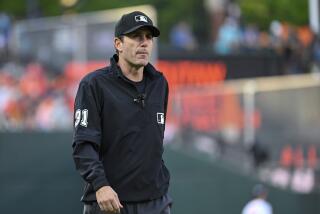Will Umpires Go Down With the Count?
- Share via
Hot topics amid the rising heat . . .
Major league umpires are concerned about e-mails and phone messages that some have received recently from Sandy Alderson, baseball’s executive vice president, regarding the need to call more strikes and reduce the number of pitches when they work the plate.
Their concern is that the integrity of the game will be compromised if they are forced to call strikes for strikes’ sake and arbitrarily abide by an average pitch count. Said a member of the crew currently working at Edison Field: “A pitch is either a ball or a strike. I’m not right every time, but I can’t change the strike zone just because the pitch count is getting high. I mean, I’ve never had reason to count pitches. Do we have to carry a calculator or something?”
In a column that appeared in Monday’s editions of The Times and dealt with the first-half results of the attempt to standardize the strike zone in conformity with the rule book, Alderson said he was satisfied how umpires had been reining in the wide strike but that they needed to call more high, low and inside strikes. He said the combined pitch counts were too often exceeding 300, illustrating that some umpires weren’t calling enough strikes and that he could document that through videotape, digital tracking, personal observation by umpiring supervisors and statistical trends.
In his subsequent e-mails and phone messages, Alderson advised umpires to “hunt for strikes” and recommended they average no more than 270 pitches when working the plate.
Alderson, reached at his San Francisco-area home Saturday, said he had contacted only about a dozen of the 80-plus umpires, focusing on those who have a high pitch count across a large sample of games and the size of their strike zone, which he found to be smaller than it should be.
“We’re not establishing a [pitch] quota and we’re not asking them to create strikes where they don’t exist,” Alderson said. “We think there are some who need to be more aggressive in their decision making, calling more strikes at the margin [of the defined zone]. Some guys have umpired for a lot of years. They have a comfort zone and don’t want to get out of it. That’s not acceptable. All we’ve done is go to the guys averaging 300 or more pitches a game and tell them their strike zone is too small and we have the evidence to support it.”
It’s all part of the attempt to provide pitchers with a better balance, pick up the pace of games and pay closer attention to the rule book.
If Big Brother is watching, so be it.
National figures in Japan, Ichiro Suzuki and Kazuhiro Sasaki believe they should be entitled to a private life in Seattle.
Unfortunately, the scrutiny has been only slightly less intense than if they were in their homeland.
Most of it has been done respectfully, but harassment by irresponsible photographers among the Japanese media prompted the Mariner stars to announce they would no longer talk to any members of the Japanese media.
The culminating event came Wednesday, when Suzuki was forced to come to a sudden stop while backing his car out of his garage to avoid hitting a group of photographers taking flash pictures.
With the arrival of Suzuki in spring training, the Mariners credentialed about 180 members of the Japanese media.
The daily entourage is much smaller, and while the majority has honored the conditions that Suzuki and Sasaki established, there will be a few who act irresponsibly, “like the National Enquirer,” Los Angeles-based reporter Atsushi Hata said.
The result is that the good are being penalized with the bad.
Said Tony Attanasio, the agent who represents both players: “They have no desire to avoid the press, but their private lives should be just that. They have the right to be left alone when they leave the field. It’s that simple.”
How can it be when one Japanese publication is reportedly offering $2 million to the photographer who gets a picture of Suzuki naked?
How long do the Chicago Cubs wait for Fred McGriff to decide if he wants to leave a last-place team for a first-place team?
How many hoops do they have to jump through, considering they have already told McGriff they will guarantee his $6.75-million option for next year and allow him to leave as a free agent after this year if he wants?
The guess is that McGriff wants additional compensation for waiving his no-trade clause, although he is saying that it strictly comes down to deciding if he wants to uproot his family from its Tampa Bay home, even though those hometown Devil Rays can’t wait to dump his salary, giving McGriff to the Cubs for virtually nothing.
With Bill Mueller sidelined by injury, Todd Hundley on a rehab assignment at triple A and Rondell White’s physical status a major concern, the Cubs can use McGriff, but only in an industry in which the inmates run the asylum would they be made to sweat like this.
In the meantime, the clubhouse attitude seems to be, “Who cares?”
“We’re not even paying attention,” said Matt Stairs, the outfielder who has been unselfishly filling the Mark Grace hole at first base, the position McGriff would play. “If it happens, it happens. We’re not going to sit on our butts and wait for him to come here and be a savior. We were in first place when the trade was made and we still are. A lot of people seem to forget that.”
Including McGriff.
More to Read
Go beyond the scoreboard
Get the latest on L.A.'s teams in the daily Sports Report newsletter.
You may occasionally receive promotional content from the Los Angeles Times.










